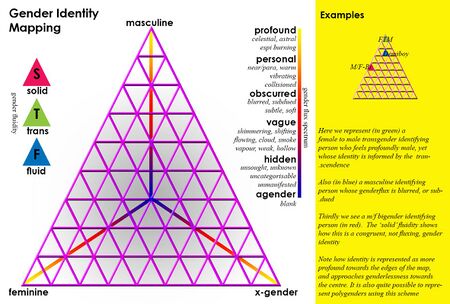Gender spectrum: Difference between revisions
imported>TXJ No edit summary |
imported>TXJ No edit summary |
||
| Line 9: | Line 9: | ||
[https://genderspectrum.org/ Gender Spectrum] is also the name of a USA-based gender inclusion organization. | [https://genderspectrum.org/ Gender Spectrum] is also the name of a USA-based gender inclusion organization. | ||
==History== | |||
The phrase "gender spectrum" dates back at least to the 1980s. For example, in a 1985 issue of the crossdressing/transsexualism magazine "Tapestry", a listing for a therapy group is described as including "transsexuals, transvestites and persons who are trying to find themselves on the gender spectrum."<ref>"Tapestry Issue 46 (1985)." Periodical. 1985. ''Digital Transgender Archive'', https://www.digitaltransgenderarchive.net/files/6682x4006 (accessed October 02, 2020).</ref> | |||
==References== | ==References== | ||
Revision as of 16:10, 2 October 2020
| |
This article lacks significant content. You can help the Nonbinary wiki by completing it! Note to editors: remember to always support the information you proved with external references! |
Gender spectrum is a term often used as a metaphor to help explain nonbinary identities.
In its most simplistic form, the gender spectrum is a line going from male on one end to female on the other end. However, this does not fully adequately include all genders; many nonbinary genders are not "between male and female".
The phrase "on the gender spectrum" is sometimes used as a synonym for "nonbinary" or "gender nonconforming".[1]
Gender Spectrum is also the name of a USA-based gender inclusion organization.
History
The phrase "gender spectrum" dates back at least to the 1980s. For example, in a 1985 issue of the crossdressing/transsexualism magazine "Tapestry", a listing for a therapy group is described as including "transsexuals, transvestites and persons who are trying to find themselves on the gender spectrum."[2]
References
- ↑ "Sexuality and Gender: Locked in, and Out". Women and Prison. 2020. p. 90.
- ↑ "Tapestry Issue 46 (1985)." Periodical. 1985. Digital Transgender Archive, https://www.digitaltransgenderarchive.net/files/6682x4006 (accessed October 02, 2020).

